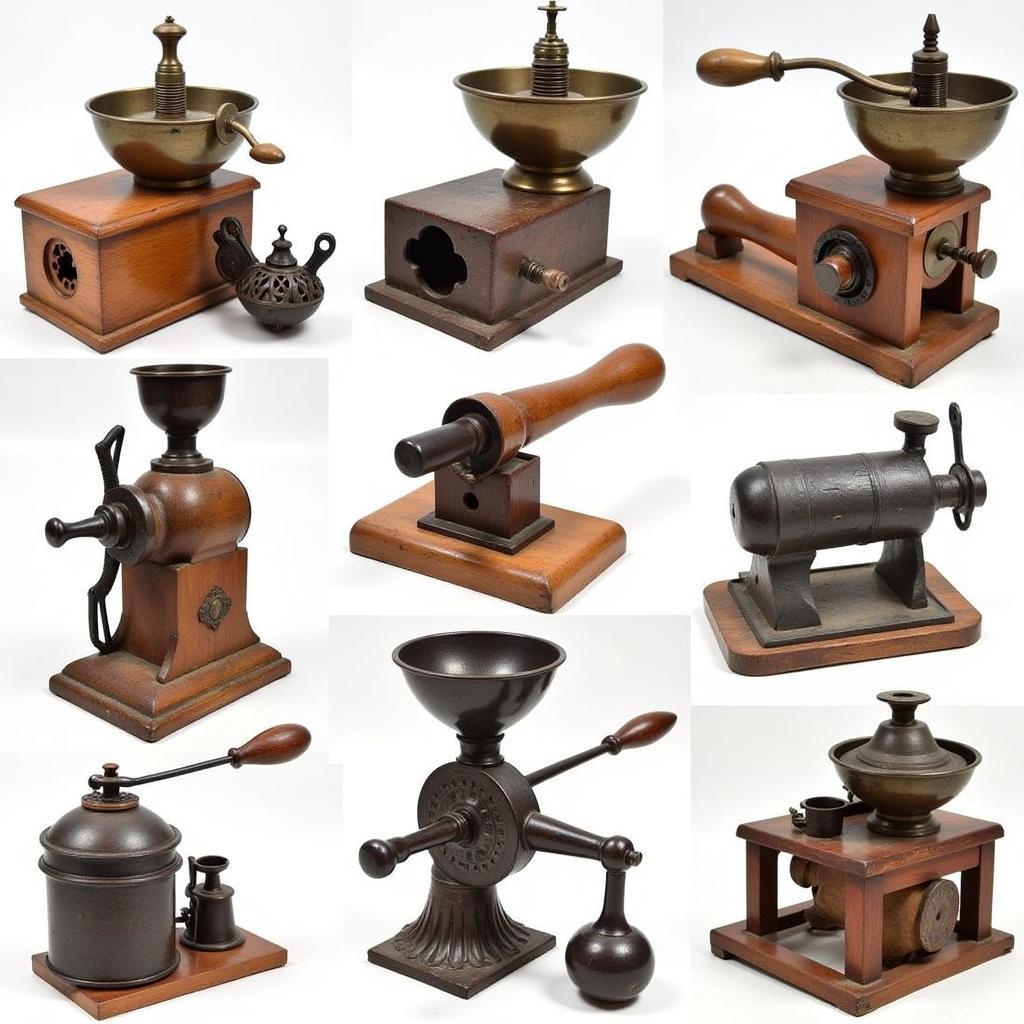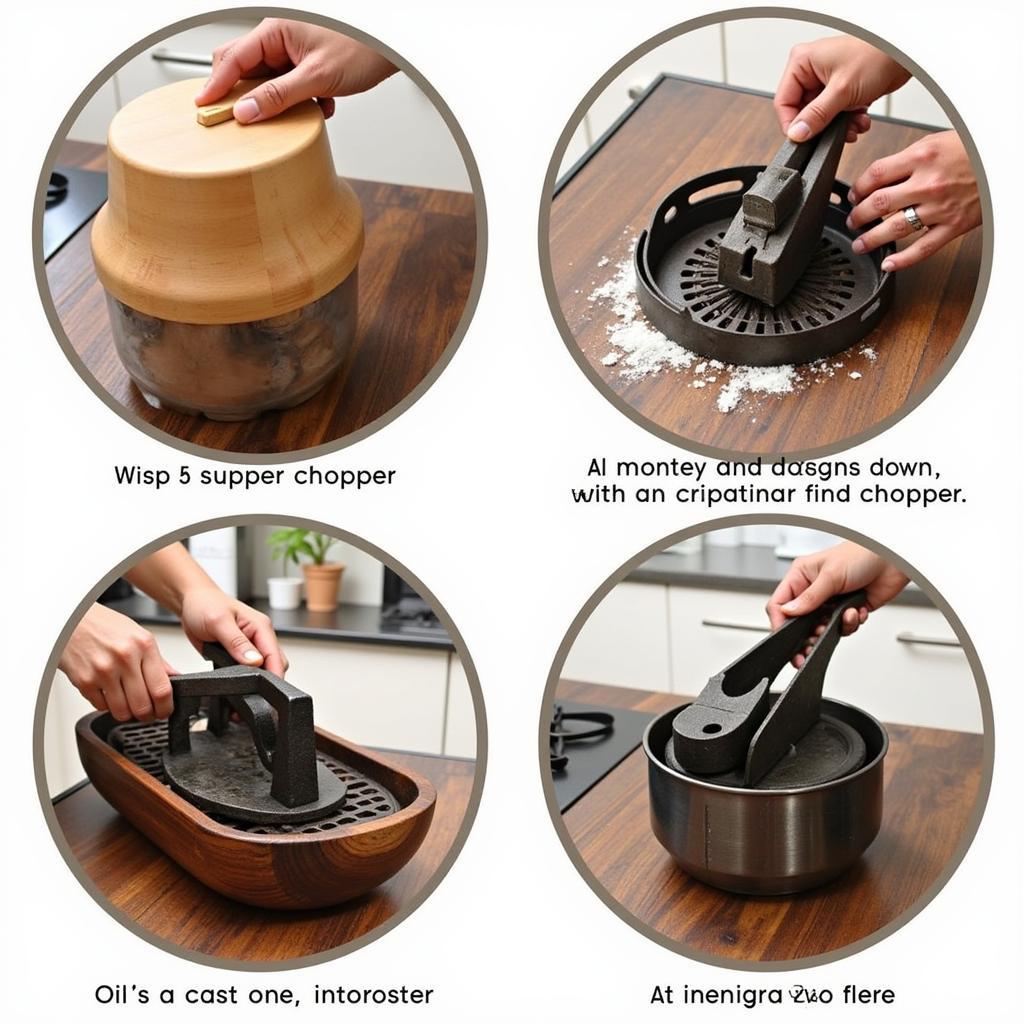Antique Food Choppers offer a fascinating glimpse into the culinary past. These ingenious tools, often crafted with intricate detail and durable materials, weren’t just practical kitchen essentials; they were a testament to the resourcefulness and ingenuity of cooks in bygone eras. Whether you’re a seasoned collector, a passionate foodie, or simply intrigued by the history of kitchen gadgets, exploring the world of antique food choppers is a rewarding journey.
The Charm of Antique Food Choppers: More Than Just a Tool
Antique food choppers hold a unique appeal, bridging the gap between functional kitchenware and historical artifacts. Unlike their modern electric counterparts, these manual choppers offer a tactile connection to the culinary traditions of the past. The rhythmic chopping, the feel of the wood or metal beneath your hands, and the satisfying thud of the blade – these sensory experiences connect us to generations of cooks who relied on these tools. They’re not just choppers; they’re storytellers.
From the simple elegance of wooden bowl choppers to the intricate mechanisms of cast iron models, antique food choppers showcase a diverse range of designs and materials. Each piece reflects the craftsmanship of its era and the specific needs of the cooks who used it. Some choppers were designed for specific tasks, like nut grinding or meat mincing, while others offered versatile functionality for a variety of ingredients. This diversity makes collecting antique food choppers a particularly engaging pursuit.
 Variety of Antique Food Choppers
Variety of Antique Food Choppers
Identifying and Dating Antique Food Choppers: A Collector’s Guide
For those interested in collecting antique food choppers, learning to identify and date these tools is essential. Several factors can help determine the age and origin of a chopper, including the materials used, the construction techniques, and any markings or manufacturer’s stamps. Cast iron choppers, for example, became popular in the late 19th and early 20th centuries, while wooden bowl choppers have a much longer history.
Examining the design and mechanisms can also offer clues. Early choppers often featured simpler mechanisms, while later models incorporated more complex gearing and blade designs. Researching specific manufacturers and their historical production periods can further refine dating estimates. Reference books and online resources dedicated to antique kitchen tools can be invaluable for identifying and valuing your finds.
Beyond the Blade: The Practical Uses of an Antique Food Chopper
While antique food choppers certainly have aesthetic and historical value, they can also be surprisingly practical tools in the modern kitchen. Many vintage choppers are still fully functional and capable of efficiently chopping vegetables, nuts, herbs, and even meat. Using an antique food chopper not only connects you to the past but also adds a unique touch to your culinary creations.
Imagine chopping fresh herbs for pesto with a beautifully crafted wooden bowl chopper or grinding nuts for a holiday recipe with a vintage cast iron grinder. These tools bring a sense of history and tradition to everyday cooking, transforming mundane tasks into mindful experiences. And, let’s be honest, they’re fantastic conversation starters.
Caring for Your Antique Food Chopper: Preserving Culinary History
Proper care and maintenance are essential for preserving the beauty and functionality of your antique food chopper. Cleaning methods will vary depending on the material of the chopper. Wooden choppers should be hand-washed and dried thoroughly to prevent cracking or warping. Metal and cast iron choppers can often be washed with soap and water, but it’s important to dry them immediately and apply a light coat of oil to prevent rust.
Avoid using harsh chemicals or abrasive cleaners, as these can damage the finish and patina of the chopper. Store your antique food choppers in a dry, cool place away from direct sunlight to prevent discoloration and deterioration. With proper care, these culinary treasures can be enjoyed for generations to come.
 Caring for Antique Food Choppers
Caring for Antique Food Choppers
Conclusion: The Enduring Legacy of the Antique Food Chopper
The antique food chopper is more than just a kitchen tool; it’s a tangible link to our culinary heritage. Whether you’re drawn to their intricate designs, their historical significance, or their practical functionality, these vintage choppers offer a unique charm that modern appliances often lack. By understanding their history, appreciating their craftsmanship, and caring for them properly, we can ensure that these culinary treasures continue to inspire and delight for years to come.
FAQ
- Are antique food choppers still usable? Many antique food choppers are still fully functional and can be used in the modern kitchen.
- Where can I find antique food choppers? Antique stores, online marketplaces, and estate sales are good places to start your search.
- How do I clean an antique food chopper? Cleaning methods vary depending on the material, but gentle hand-washing is usually recommended.
- What are the different types of antique food choppers? There are various types, including bowl choppers, rotary choppers, and grinders.
- How do I date an antique food chopper? Look for manufacturer’s marks, examine the materials and construction techniques, and consult reference books.
- What are antique food choppers worth? The value can vary widely depending on the age, rarity, and condition of the chopper.
- How do I store an antique food chopper? Store in a dry, cool place away from direct sunlight.
For support, please contact Phone Number: 02437655121, Email: minacones@gmail.com Or visit: 3PGH+8R9, ĐT70A, thôn Trung, Bắc Từ Liêm, Hà Nội, Việt Nam. We have a 24/7 customer service team.